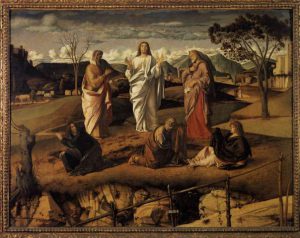This Second Sunday of Lent we listen once again to the Gospel account of Jesus’ transfiguration. As the Gospel acclamation was sung, and the deacon lifted the Book of the Gospels, I thought to myself: “We are fulfilling the command of God from the Gospel today. This Gospel is Jesus, and we are listening to Him.”
As the Gospel was proclaimed, I thought once again: “The Lord led Moses by a cloud by day and a column of fire by night. God spoke to Moses from a burning bush, again when He gave Him the Ten Commandments, and face-to-face in the meeting tent. God spoke to Elijah in a soft breeze from the mountain top.” Here are the great figures of the Law and the Prophets, now conversing with Jesus about His impending death.
In Jesus, the Law and the Prophets are fulfilled. Perhaps this is why after the Voice of God proclaims: “This is my beloved Son. Listen to Him. Moses and Elijah are no longer visible. In this moment, Jesus is revealed in all His Glory.
Prior to the transfiguration, Jesus had been telling His apostles that He must go to Jerusalem, where He would be handed over, crucified, die, and rise from the dead. His apostles were struggling with this strange prediction of the cross. In His preaching, Jesus told his followers; “If you wish to by My disciples, you must daily take up your cross, and follow me.” We, too, do not find this a particularly attractive instruction of Jesus.
In the Book of Genesis, we hear about Abram being sent by God to a new land. Abram is invited to trust God and His promise. He is told that God will bless Him, and that his own life would be a blessing to many. We, too, are invited to trust God in this earthly pilgrimage to our heavenly home-land. Our life, too, is meant to be a blessing to others.
St. Paul instructs Timothy (and all believers) with a similar teaching of Jesus: “Bear your share of hardship which the Gospel entails, with the strength that comes from God.” Here I think we find a key to understanding the transfiguration of Jesus before a few of his hand-picked witnesses.
Jesus knew the ‘hardship’ that was before Him, and the hardship that awaits all of His disciples. He knew His apostles were wrestling with the reality of the cross. He wanted to give them a reassurance of what lies beyond the cross – namely, Light, Life, and Glory. Jesus knows even today those who struggle with the trials and burdens of this life. He knows of our weakness when it comes to suffering on His behalf. Indeed, some find the cost of such suffering to great, and abandon the faith all together. He wants to bolster our faith.
When we bear the cross as it is associated with Christ, we can at times become confused and disheartened. The pain of such suffering can cause us to lay down our cross, turn away from Christ (temporarily in sin.) It is in these moments that we are to remember the Glory that is just beyond the cross.
I have often questioned God about the sacrifices that are a part of my own journey. My ‘limited view’ of things can easily miscalculate the work of God in such moments, and can only judge the moments from a ‘selfish’ perspective. My spiritual director recently gave me a great question to pray with in this regard. “What is God’s desire for you in the midst of this struggle?” Prayer with this question quickly provided the right perspective…God’s perspective.
The Second Vatican Council “exhorts the faithful to contribute to the good of the People of God by freely uniting themselves to the passion and death of Christ.” (Lumen Gentium #11) This is what Jesus was helping Peter, James and John understand, and it is His desire for you and I. We are to bear our cross with the same intention as Jesus. We are to bear our sufferings with the same love of Jesus. And when we fail in our struggles and slip into sin, we are once again to turn trustingly to the mercy of God.
God uses even our sins to prick our conscience to cause us to turn back (conversion) to a faithful walk with Christ. Our sins can haunt us, and they are meant to. This, too, is a suffering for us. So, life eventually teaches us that it is far better to suffer for good rather than evil. It is far better to suffer here and now than for all eternity.
The transfiguration of Jesus revealed not only His future glory, but the future glory of all who follow Him. Let us bear our share of hardship which the Gospel entails, with the strength provided by God, and we shall one day know and see the Glory of the LORD in all its fullness, and we will share in the immortality and Light of the Gospel.
+pde
0